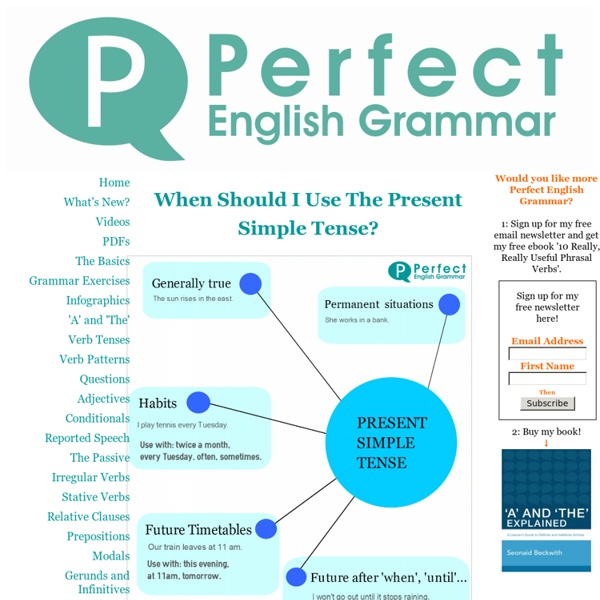Present Simple Use

Form
(Download this explanation in PDF) We need to use the Present Simple a lot in English, so it's really important to understand it well. Many students have problems with the form (or how to make it). If you'd prefer to learn about how to USE the Present Simple jump to this page.Or, click here for all the practice exercises about this tense. Simple present tense with 'be' The verb 'be' is different from the other verbs in this tense. Here's the positive form (positive means a normal sentence, not a negative or a question. Click here to practise making the positive with 'be'. Next, here's the negative. Click here to practise making the negative with 'be'. And finally let's talk about the question form of the present simple with 'be'. Firstly, here's the 'yes / no' question form: Click here to practise making yes / no questions with 'be'. If you'd like to make a 'wh' question, you just put the question word at the front: Click here to practise making 'wh' questions with 'be' . Don't forget the 's'!
Present Simple Exercise 4
Here's another negative present simple exercise - type the whole sentence into the box and click 'check'. Click here to review how to make the present simpleClick here for another exercise about making the present simple negativeClick here to download this exercise in PDF (with answers) Learning English as a foreign language: Tip #4 Do grammar exercises about the English verb tenses until you feel really confident about how to make the tense. Click here for more present simple exercises
Motivacija za učenje - Životna škola
Važno je razlučiti proizlaze li slabe ocjene zbog slabe motivacije ili zbog teškoća pri učenju kao što su slabo pamćenje, loše povezivanje činjenica, pogrešno zaključivanje, neuočavanje bitnoga, nerazumijevanje gradiva, slaba koncentracija, disleksija, ADHD i slično. Ovaj članak odnosi se samo na rješavanje problema averzije i pada motivacije za učenje. Kao prvo, dobro je znati pravi uzrok zašto Vaše dijete nema volju za učenjem i prema tome poduzeti odgovarajuće mjere. Svako je dijete drugačije i ono što jedno motivira, ne mora i drugo. Ovdje ćemo se prvo pozabaviti traženjem i pronalaženjem pravog uzroka kako bismo mogli prijeći na pravo rješenje. Kada dijete ne voli učiti, većina roditeljai misli da je problem u djetetu, no često je problem u roditeljima. Najčešće se događa da roditelji misle jedno, a iza djetetova ponašanja krije se nešto sasvim drugo. Neki od uobičajenih uzroka averzije prema učenju i pada motivacije su
Present Simple Exercise 1
Here's an exercise where you need to make the present simple positive. Click here to review how to make the present simple tense.Click here to download this exercise in PDF (with answers)Click here for more present simple exercises Don't forget the 's'! Learning English as a foreign language: Tip #1 Read often in English. Click here for more present simple exercises
Present Simple Exercise 3
Here's an exercise where you need to make the present simple negative. Click here to review how to make the present simple. Click here to download this exercise in PDF (with answers)Click here for more present simple exercises Learning English as a foreign language: Tip #3 Try reading a newspaper in English - there will be a lot of difficult words, it's true, but don't try to read the whole thing at once. Click here for more present simple exercises
C1 level English language practice tests
Exam English ✓ Free Practice Tests for learners of English Practice tests at C1 level The following practice tests are at C1 level: CAE About CAE | Reading 1 | Reading 2 | Reading 3 | Reading 4 | Listening 1 | Listening 2 | Listening 3 | Listening 4 | Listening | Use of English 1 | Use of English 2 | Use of English 3 | Use of English 4 | Use of English 5 BEC Higher BEC Higher: Reading part 1 | Reading part 2 PTE General Level 4 Level 4 listening | Level 4 reading | The following are multi-level exams that encompass C1 level: TOEFL Reading: Reading 1| Reading part 1 | Reading part 2 | Reading part 3 Listening: Lecture 1 | Lecture 2 | Lecture 3 | Lecture 4 | Conversation 1 | Conversation 2 | Conversation 3 Vocab & Structure: Vocabulary test | Structure test 1 | Structure test 2 | Structure test 3 | Structure test 4 TOEFL Tips | TOEFL Junior | About TOEFL PTE Academic PTE Academic: listening test 1 | listening test 2 | listening test 3 2014 © Exam English Ltd.
Present Simple Exercise 2
Here's another exercise where you need to make the present simple positive. Click here to review how to make this tense.Click here to download this exercise in PDF (with answers)Click here for another present simple positive exercise. Don't forget the 's'! Learning English as a foreign language: Tip #2 Watch films and TV in English. Try another exercise about the simple present here Return to the grammar exercises page
Related:
Related:



